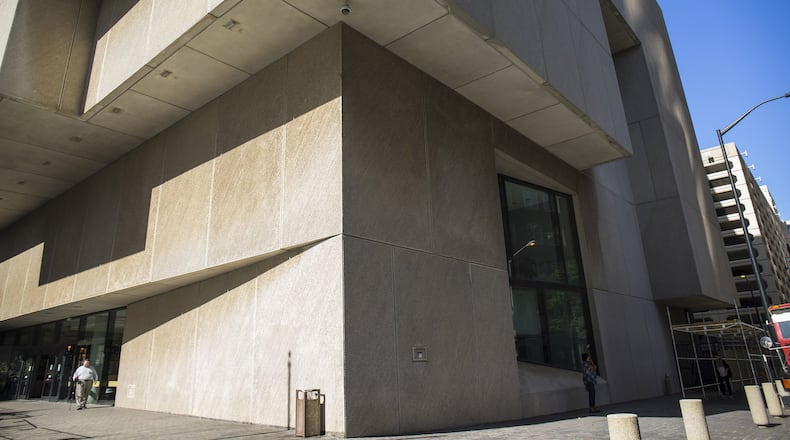The Georgia Trust for Historic Preservation on Wednesday released its 2017 list of 10 Places in Peril.
This is the 12th year for the list, which highlights endangered historic properties in the state.
The list is designed to raise awareness about the state’s historic and cultural resources such as buildings, districts and sites at risk of neglect, demolition, maintenance issues, inappropriate development or public policy.
Of the 10 sites, four are located in metro Atlanta, including the formidable Atlanta Central Library located downtown, which was built in 1980 as an internationally significant example of brutalist architecture. It was the last building designed by renowned architect Marcel Breuer.
The library was threatened with demolition when a bond referendum passed to fund the construction of a new central library. After public outcry and a re-evaluation of the existing building, the Fulton County Commission voted in 2016 to use the library bond to fund the building’s rehabilitation instead. Rehabilitation plans are pending, and there is concern that the project may not respect Breuer’s original design.
Each building “has its own story,” said Mark C. McDonald, president and CEO of the Georgia Trust for Historic Preservation. “The strategy is to save them. There’s no reason to put them on the list if we can’t find a viable alternative to demolition.” So many buildings are endangered that it’s “hard to get it down to 10.”
Another listing in metro Atlanta is Mimosa Hall in Roswell. The Greek Revival-style home was designed for Roswell founding father John Dunwoody and built in 1840 and rebuilt in 1847 following a fire. Mimosa Hall was named for its many mimosa trees by a later owner, Gen. A.J. Hansell, prior to being purchased in 1916 by noted Atlanta architect Neel Reid, who renovated the house and its iconic gardens. In 1947, Granger Hansell, great-grandson of the home's former owner, purchased Mimosa Hall, and it has remained in the Hansell family ever since.
Mimosa Hall, along with 21 undeveloped acres, is currently on the market. The significant acreage of the estate in historic downtown Roswell creates an elevated threat of development.
Others in the metro area include Gaines Hall, Furber Cottage, Towns House and Hamilton House, which are grouped together as one, in Atlanta and Lyon Farmhouse in Lithonia.
Gaines Hall, Furber Cottage, Towns House and the Hamilton House are located within the Atlanta University Center Historic District; they stand vacant and deteriorating, according to the Trust. Gaines Hall, built in 1869, was the first permanent building on the Atlanta University campus. Furber Cottage, built 30 years later, served as a dormitory. The 1910 Towns House was home to George A. Towns, a professor at Atlanta University and close friend to W.E.B. DuBois. Towns’ daughter, Grace Towns Hamilton, became the first African-American woman elected to a state legislature in the Deep South. She and her husband built the ranch-style Hamilton House in 1950.
It’s perhaps no surprise that most of the sites on the list are in rural areas.
In smaller, rural areas, there’s less economic development, and downtowns “are crumbling,” McDonald said. “In Atlanta, it’s a different story. There’s so much growth and development in Atlanta that sometimes historic buildings — which may be smaller buildings on a large lot — are torn down to make way for a larger building. It’s a tale of opposites.”
There is, however, reason to be optimistic.
DeKalb Watershed Management is going to give Arabia Mountain Heritage $100,000 to stabilize historic Lyon Farmhouse, which was included on the 2017 list and is one of the oldest houses in the county.
It was built by Joseph Emmanuel Lyon, a former British soldier who was awarded 100 acres for taking the Oath of Allegiance after being captured and serving with the patriots during the American Revolution. The site has been expanded multiple times. The property is within the Arabia Mountain Heritage Area and a PATH trail passes nearby, but the house suffers from continued vandalism and deterioration.
Other sites on the list include:
Calvary Episcopal Church and Lee Street Bridge in Americus (Sumter County).
Chivers House in Dublin (Laurens County).
Marble YMCA Building in Columbus (Muscogee County).
John Rountree Log House in Twin City (Emanuel County).
Charles T. Walker House in Augusta (Richmond County).
Old Zebulon Elementary School building in Zebulon (Pike County).
RELATED:
Future of Atlanta’s Central Library is in question
Preserving Flat Rock community
About the Author
Keep Reading
The Latest
Featured


